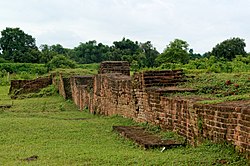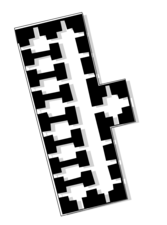Historic cities of the Pyu
| Historic cities of the Pyu | |
|---|---|
|
UNESCO world heritage |
|

|
|
| Remains of the palace of Sri Ksetra |
|
| National territory: |
|
| Type: | Culture |
| Criteria : | (ii) (iii) (iv) |
| Surface: | 5809 ha |
| Buffer zone: | 6790 ha |
| Reference No .: | 1444 |
| UNESCO region : | Asia and Pacific |
| History of enrollment | |
| Enrollment: | 2014 (session 38) |
Historic Cities of the Pyu is one of the UNESCO -listed site of World Heritage in Myanmar . The world heritage site includes three ruined cities of the Pyu people, who formed one of the first advanced civilizations in Southeast Asia in the first millennium AD .
background
The Tibetan Burmese people of the Pyu lived in the area of what is now Myanmar in the first millennium AD. They established several city-states there, each of which was presumably ruled by its own king. The cities had partly a round plan, partly a rectangular one. Some of these cities were on the Irrawaddy , but most of them were off its tributaries.
The Pyu had developed a sophisticated irrigation system for agriculture, and canal systems can still be found around the city facilities. Originally influenced by Hinduism, the Pyu adopted Buddhism in the 2nd to 3rd centuries , according to inscriptions from the Theravada school tradition .
registration
Historic cities of the Pyu were registered as cultural heritage sites in the list of UNESCO World Heritage in 2014 based on a resolution of the 38th session of the World Heritage Committee. The reason for the entry states, among other things:
The historic cities of the Pyu are the earliest evidence of the introduction of Buddhism into Southeast Asia nearly two thousand years ago and the associated economic, socio-political and cultural changes that led to the rise of the region's first, largest and longest-standing urbanized settlements into 9th century led. ... Halin, Beikthano and Sri Ksetra together testify to the various aspects of the development of this new urban settlement model for the Southeast Asian region.
The entry was made on the basis of criteria (ii), (iii) and (iv).
(ii): Through the interaction of indigenous Pyu societies with Indian cultures from the 2nd century BC. Buddhism reached its first permanent place in Southeast Asia in the Pyu cities, where it was adopted by all strata of society from the ruling elite to the agricultural workers. Characterized by imposing memorial stupas and other sophisticated forms of brick ritual buildings, the historic Pyu cities are the earliest evidence of the emergence of these innovative forms of architecture in the region, some of which have no known prototypes. The development of the urban Budhist culture of the Pyu had far-reaching and lasting effects throughout Southeast Asia and gave impetus to the later state formation after the 5th century after the transmission of Buddhist teaching and monastic practice to other parts of the Southeast Asian mainland.
(iii): The historic Pyu cities marked the emergence of the first historically documented Buddhist urban civilization in Southeast Asia. The establishment of educated Buddhist monastic communities came about along with the restructuring of agricultural production based on the expert handling of seasonally scarce water resources and the specialized production of industrial goods in terracotta, iron, gold, silver and semi-precious stones for cult and trade. Buddhism underpinned the construction of religious monuments in brick under royal and general public auspices, marked by the shift from earlier wood construction techniques to durable materials. The Pyu developed unique burial practices using funeral urns to store cremated remains in communal burial grounds. Trade networks linked the ancient Pyu cities with trade centers in Southeast Asia, China, and India. Through this network, Buddhist missionaries carried their Pali-based teachings to other areas on the Southeast Asian mainland.
(iv): Technological advances in resource management, agriculture, and the manufacture of brick and iron in the historic Pyu towns paved the way for significant advances in urban planning and building construction. These innovations led to the rise of the first three, largest, and longest-lived Buddhist settlements in all of Southeast Asia. The urban morphology of the Pyu cities set a new standard for an expanded urban format, characterized by massive closed walls surrounded by ditches: a network of streets and canals that divides the urban space within the walls with extensive areas of extramural development connects, with civic institutions, monumental religious structures bounded by towering stupas and sacred waters. At or near the center of each ancient city was an administrative complex that marked the palace as the cosmic center of the Pyu political and social universe.
scope
The serial world heritage site consists of three separate areas. These cover a total of 5809 ha of protection . The individual protection areas are each surrounded by buffer zones, which have a total area of 6790 ha.
| Ref.No. | designation | location | Protection area | Buffer zone |
|---|---|---|---|---|
| 1444-001 | Halin |
Mandalay region ( geographic coordinates ) |
1,243 ha | 2,198 ha |
| 1444-002 | Beikthano |
Magwe region ( geographic coordinates ) |
1,188 ha | 2,879 ha |
| 1444-003 | Sri Ksetra |
Bago region ( geographic coordinates ) |
3,378 ha | 1,713 ha |
The individual cities
Beikthano
Beikthano was one of the earliest cities of the Pyu. It originated in the second or first century BC and lost its importance in the fifth century. The city had a rectangular ground plan of about 1 km × 3 km and was surrounded by a brick wall, of which there are remains up to two meters high. Excavations took place from 1959 to 1962. 25 brick buildings were found, including a palace district, a monastery and a house of the dead. Hardly any inscriptions or figures were found.
Sri Ksetra
Sri Ksetra was the largest city of the Pyu. It is said to have been founded in 94 AD and was abandoned in 656. The city had a circular floor plan, 4.4 km in diameter and was surrounded by a brick wall. First excavations took place in 1904, in 1991 a palace was excavated in the center of the city. Other excavated structures are stupas , pagodas and temples. Gold, bronze and stone sculptures and inscriptions in Sanskrit , Pali and Pyu were also found.
Halin
Halin was the third largest city of the Pyu. It had a rectangular floor plan about 1.5 km by 3 km and was surrounded by a brick wall. In the middle of the place there was also a walled palace complex. Excavations took place from 1904 to 1905, 1929 to 1930 and 1963 to 1967. Mainly urns, inscriptions and statues were found. The fact that hardly any architectural remains were found is attributed to the fact that wood was the main building material.
photos
literature
- Historic cities of the Pyu . In: The World Heritage . Frederking & Thaler, Munich 2015, ISBN 978-3-95416-181-2 , pp. 877 .
- Historic cities of the Pyu . In: The UNESCO World Heritage . Kunth Verlag, Munich 2017, ISBN 978-3-95504-413-8 , pp. 466 .
Web links
Individual evidence
- ↑ Official name English Pyu Ancient Cities , French Anciennes cités pyu , German translation according to the World Heritage List. In: www.unesco.de. Retrieved November 8, 2017 .
- ↑ a b c d Pyu Ancient Cities. In: whc.unesco.org. UNESCO World Heritage Center, accessed November 8, 2017 .
- ↑ Decision: 38 COM 8B.28. In: whc.unesco.org. UNESCO World Heritage Center, accessed November 12, 2017 .
- ^ Pyu Ancient Cities. Maps. In: whc.unesco.org. UNESCO World Heritage Center, accessed November 12, 2017 .






